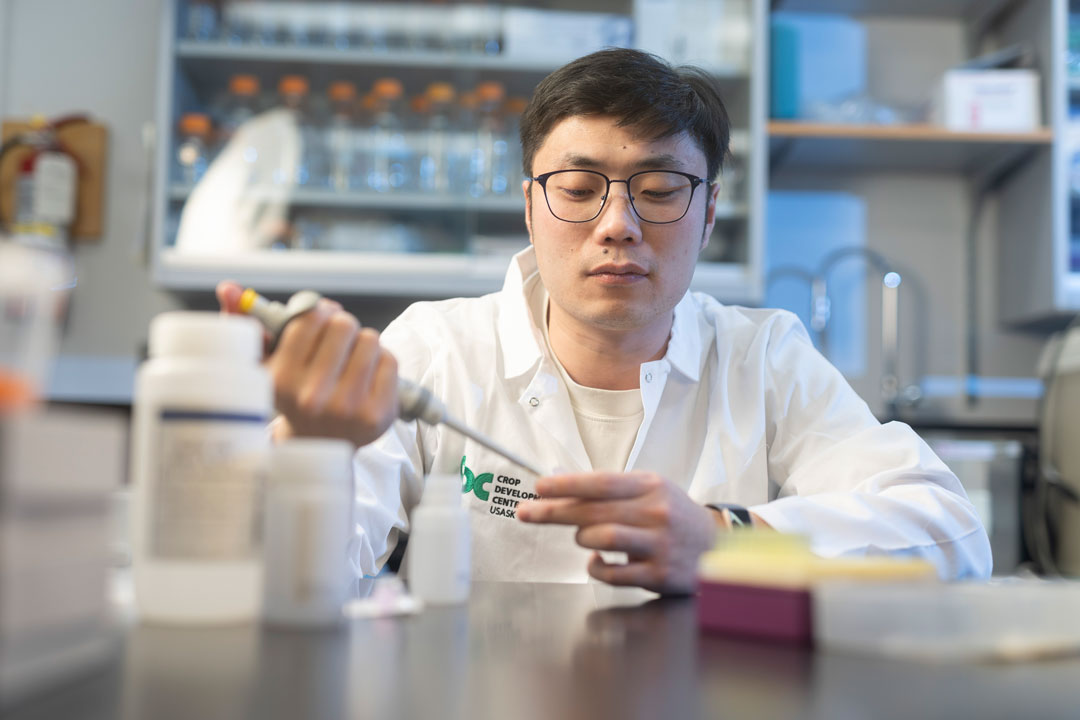
USask student uses genomics to accelerate pea breeding for heat resistance
Shaoming Huang is using advanced sequencing technology to shorten the breeding cycle of field peas.
By Nykole KingHuang is a PhD student in the Crop Development Centre in the College of Agriculture and Bioresources at the University of Saskatchewan (USask). The goal of his research is to develop pea varieties that can better tolerate the Prairie summer heat.
“In breeding work, nowadays, we're using DNA markers to make selections before (conducting) field trials, all with the aim to shorten the breeding cycle,” Huang says.
Shortening the breeding cycle will reduce the length of time for researchers to find heat-resistant pea varieties, effectively saving producers time and money with a superior seed variety.
Huang is originally from Qingdao, a coastal city in Shandong province, China, that is best known for its agriculture. Before coming to Canada, he completed a Bachelor of Science in plant biotechnology at Jilin University in China, where he learned various molecular biological techniques.
During Huang’s graduate studies at USask, he learned how to master more complex genomic technologies. He was one of the first people in the pulse breeding group at the Crop Development Centre (CDC) to apply transcriptomics – the study of gene expression – to pea, which he says sometimes presented him with a “learning curve.”
“We always underestimate the complexity of the research,” Huang says about the challenges he has faced while completing his PhD research.
“I was the first person in the lab performing the most advanced transcriptome sequencing techniques, and we actually found that the heat responsive genes can be in the few thousands,” Huang says. “It can be difficult to simultaneously analyze those few thousand genes… We can have lots of data but interpreting its biological meaning can really be challenging.”
In 2013, Huang moved to Canada to pursue a Master’s degree under the supervision of Dr. Rosalind Bueckert, a professor and researcher in the Department of Plant Sciences. He selected USask because it was ranked 11th in Canada in Maclean magazine’s University Rankings, coincidentally the same ranking as his alma mater in China.
After completing his master’s, Huang started his PhD under the supervision of Dr. Tom Warkentin (PhD), who is the Ministry of Agriculture Strategic Research Program Chair in Pulse Crop Breeding and Genetics and a professor in the Crop Development Centre.
During his graduate studies, Huang published three research articles in journals, and submitted a fourth article for review. He successfully defended his thesis work in late June.
While reflecting on the best parts of his graduate student experience, Huang says that while he enjoys the complexities of genomics, the highlight for him was getting out of the lab and working outside in field trials each year.
Huang and his wife plan to stay in the Saskatoon area because it is a hub for agricultural research. His goal is to work carrying out research in an independent role at the senior level.
Huang is grateful for all the opportunities he was provided with at the CDC. He is especially proud of the achievement of earning third place for his oral presentation at the North American Pulse Improvement Association (NAPIA) in 2021.
“I learned a lot from these years,” Huang says. “Being a teaching assistant for two courses and attending different conferences to make presentations and learn about my field and other perspectives — these are great learning opportunities and experiences from these years.”
To learn more about how to apply for graduate student opportunities with the Crop Development Centre, please visit the Plant Sciences graduate studies webpage
